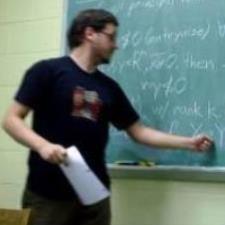
Nicholas A. answered • 05/10/22
ASU Barrett Honors Student Math and Physics Tutor
First, let's start by writing a differential equation to model our scenario:
The amount of salt in the tank at time t will be represented by Q(t), so the rate at which the amount of salt in the tank is changing can be written as Q'(t).
Q'(t) = rate that salt is going into the tank - rate that salt is coming out
lb/gal * gal/min = lb/min -> this gives us our rates
Q'(t) = 1lb/gal * 4 gal/min - 2 gal/min * Q(t)/(10+2t)
Q(t)/(10+2t) represents the amount of salt in the tank at a given time divided by the amount of liquid in the tank at a given time--- we do this because the concentration of the mixture coming out will be the same of that in the tank (assuming the mixture is well-stirred)
Q'(t) = 4 -2Q(t)/(10+2t)
Using the method of integrating factors to solve the differential, we obtain Q(t) = (4t2+40t+C)/(10+2t). Since we know that Q(0) = 3 (from the initial condition of having 3lb of salt in the tank), we can solve for C and get C = 30.
From there we can plug in t = 5 since we know that is how long it will take for the system to get to the overflowing level (there is a net accumulation of 2 gal/min and the system begins with 10 gal and overflows at 20 gal). This gives us Q = 16.5 lb
Hopefully, this helps!!!




